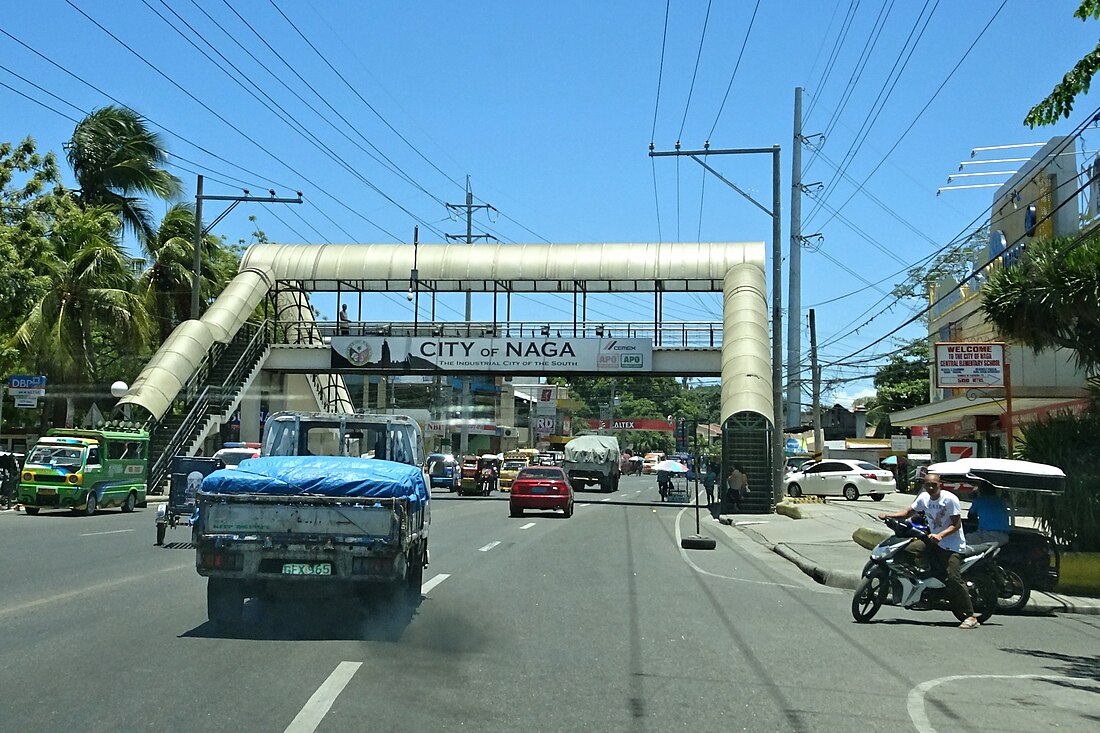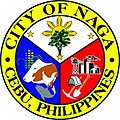Top Qs
Timeline
Chat
Perspective
Naga, Cebu
Component city in Cebu, Philippines From Wikipedia, the free encyclopedia
Remove ads
Naga, officially the City of Naga (Cebuano: Dakbayan sa Naga; Filipino: Lungsod ng Naga), is a component city in the province of Cebu, Philippines. According to the 2024 census, it has a population of 138,727 people.[6]
Naga City is bordered to the north by the town of Minglanilla, to the west is the city of Toledo, to the east is the Cebu Strait, and to the south is the town of San Fernando. It is 21 kilometres (13 mi) from Cebu City.
It lies within the Cebu metropolitan area.[7]
It is one of the two Philippine cities named Naga, the other being Naga, Camarines Sur in Luzon.
Remove ads
History
Summarize
Perspective
Colonial Era
Naga was previously named by the first settlers as Narra due to the abundance of narra trees. The name eventually became Naga. Naga became a municipality on June 12, 1829. It was partitioned from San Nicolas, now part of Cebu City. The original barrios are Inayagan, Tinaan, Langtad, Pandan, Cantag-an, Lutac, Uling, and Alpaco.[8][9]
Soon after, Spanish authorities discovered coal in the upland barangays of Uling and Lutac. However, mines were developed intermittently.[10] In 1901, during American occupation, the Uling-Lutac coal and rail concession (also known as the Macleod concession) was identified as one of the three coal mines in Cebu that the government wanted to develop further.[11]
In 1921, the Philippine government established the first cement plant in the country in Tinaan, Naga. It was called Cebu Portland Cement Company (CEPOC). Today, the plant still exists and able to produce 3.8 million metric tons (MMT) of cement per year. It is now known as the APO Cement Plant.[12]
During World War II, around three-quarters of the town was destroyed.[13]
Post-war Era
The manufacturing and industrial sector continued to grow in Naga. The Naga Coal Plant was established in 1981. It was the first grid-connected coal plant in the country and was built for the National Power Corporation. It had a capacity of 105 MW up to its retirement in 2015.[14]
Cityhood
Cityhood was ratified in a plebiscite on September 2, 2007. The Supreme Court declared the cityhood law of Naga and 15 other cities unconstitutional after a petition filed by the League of Cities of the Philippines in its ruling on November 18, 2008. On December 22, 2009, the cityhood law of Naga and 15 other municipalities regain its status as cities again after the court reversed its ruling November 18, 2008 ruling.
On August 23, 2010, the court reinstated its ruling on November 18, 2008, making Naga and 15 other cities regular municipalities. Finally, on February 15, 2011, Naga and the other 15 municipalities declared that the conversion to cityhood met all legal requirements. In 2013, after six years of legal battle, in its board resolution the League of Cities of the Philippines acknowledged and recognized the cityhood of Naga and 15 other cities on July 19, 2013.[15][16]
Remove ads
Geography
Summarize
Perspective
Barangays
Naga is politically subdivided into 28 barangays. Each barangay consists of puroks and some have sitios.
Climate
Remove ads
Demographics


Economy
Summarize
Perspective
Poverty incidence of Naga
10
20
30
40
2000
37.85 2003
19.56 2006
31.40 2009
27.10 2012
17.23 2015
21.12 2018
15.30 2021
26.02 Source: Philippine Statistics Authority[24][25][26][27][28][29][30][31] |
Naga is home to several heavy industries, and as such, the city bills itself as the Industrial City of the South. Among the industries in Naga are the Apo Cement Corporation, the largest factory in the country, producing 4,000 metric tons (3,900 long tons) per day; FSP Group; the 290-megawatt KEPCO Philippines Corporation power plant; MRC Allied Industries; Pryce Gases, Inc.; Rikio Southeast Asia; the 147-megawatt coal-fired Salcon Power Corporation plant;[1] Asian Grains Corporation, a flour milling company; Sugbo ACS Food Manufacturing Corporation, the maker of Ichipan bread; UNAHCO Feeds, Inc.; and Provera Nutritional Solutions Corp. (feedmill), among other industries.
The Naga Valley Industrial Park (NAVA) is a 36 ha (89 acres) Philippine Economic Zone Authority (PEZA)-registered industrial park in Barangay Cantao-an. Locators in NAVA include Cebu Mitsumi, Inc., Kyocera Kinseki Philippines, Inc., and Tokyo Microshaft Corporation. The industrial park was a part of the 250 ha (620 acres) New Cebu Township One (NCTO) of MRC Allied before it was acquired by Cebu City-based developer Primary Properties Corporation.[32]
Remove ads
Sports venues
In December 2015, the Naga City government officially opened the Teodoro Mendiola Sports Field and Oval, located along North Poblacion. Its inauguration was in time for its usage as the main venue for the 2016 Central Visayas Regional Athletic Association (CVIRAA) games in February. The ₱68 million project comprises a track and field oval, swimming pool (Olympic-sized), and basketball, tennis, and volleyball courts.[33]
2017 the first time a host became back-in-back in the venue for the CVIRAA again.[34]
Remove ads
References
Sources
External links
Wikiwand - on
Seamless Wikipedia browsing. On steroids.
Remove ads






